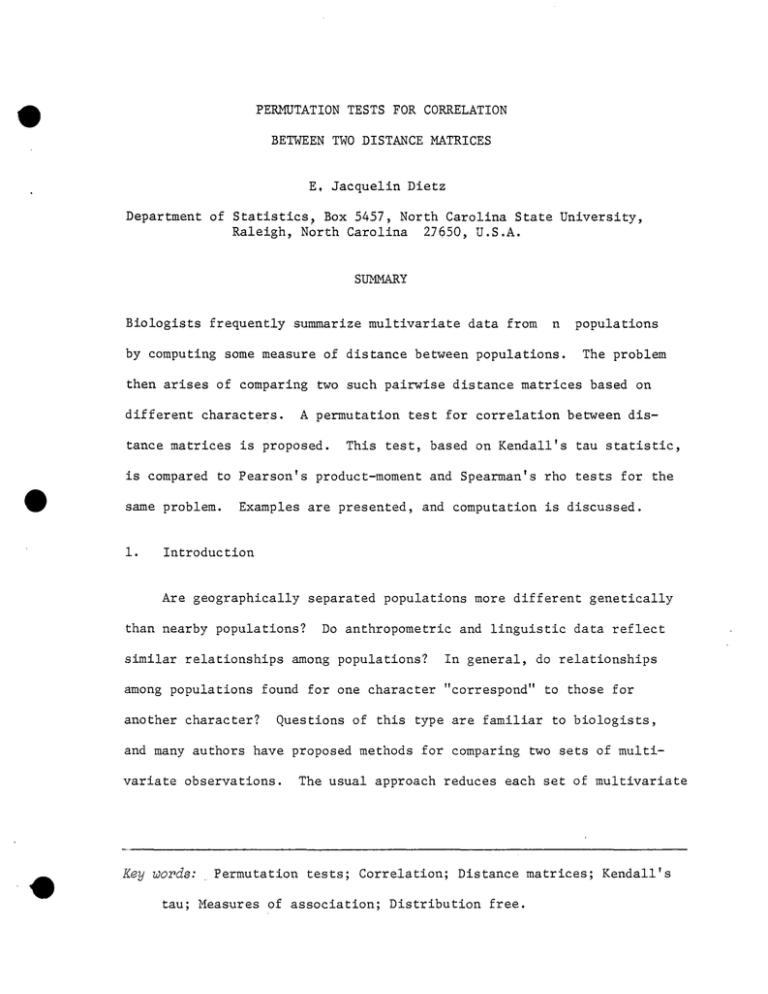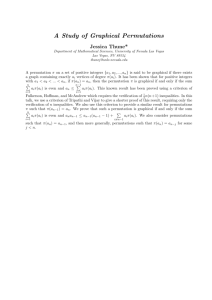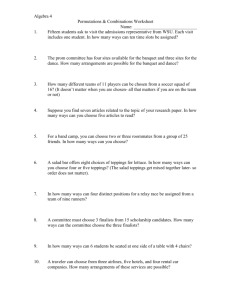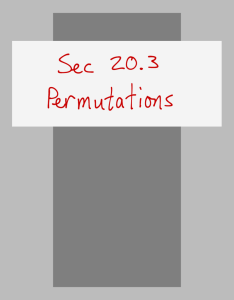PERMUTATION TESTS FOR CORRELATION BETWEEN TWO DISTANCE MATRICES E, Jacquelin Dietz Department of
advertisement

PERMUTATION TESTS FOR CORRELATION
BETWEEN TWO DISTANCE MATRICES
E, Jacquelin Dietz
Department of
Statistics~ Box 5457, North Carolina State University,
Raleigh, North Carolina 2]650, U.S.A.
SUMMARY
Biologists frequently summarize multivariate data from
n
by computing some measure of distance between populations.
populations
The problem
then arises of comparing two such pairwise distance matrices based on
different characters.
A permutation test for correlation between dis-
tance matrices is proposed.
This test, based on Kendall's tau statistic,
is compared to Pearson's product-moment and Spearman's rho tests for the
same problem.
1.
Examples are presented, and computation is discussed.
Introduction
Are geographically separated populations more different genetically
than nearby populations?
Do anthropometric and linguistic data reflect
similar relationships among populations?
In general, do relationships
among populations found for one character "correspond" to those for
another character?
Questions of this type are familiar to biologists,
and many authors have proposed methods for comparing two sets of multivariate observations.
Key
words:
The usual approach reduces each set of multivariate
Permutation tests; Correlation; Distance matrices; Kendall's
tau; Measures of association; Distribution free.
2
data to some measure of generalized distance between populations.
The
problem is then to compare the resulting pairwise distance matrices.
Some authors (Howells 1966, McKechnie, Ehrlich and White 1975)
have simply calculated the sample correlation coefficient
the pairwise distances.
test the significance of
r
between
The normality assumption required in order to
r
is suspect for many distance measures
(see e.g., Friedlaender et aZ. 1971, p. 267).
are the dependencies among the
(~)
More problematic, however,
pairwise distances for
n
populations.
The degrees of freedom for a correlation test are surely overestimated
when the test is applied to such data.
These difficulties have been
discussed (Friedlaender et aZ. 1971, Spielman 1973), but valid tests for
correlation between distance measures are not widely known.
Alternative techniques for comparing sets of data have been proposed.
Spielman (1973) uses networks or trees derived from distance measures
to represent relationships among populations.
Using path lengths of the
networks, he tests whether two sets of data give rise to similar cluster
structures.
Corruccini, Cronin and Ciochon (1979) perform a principal
coordinates analysis for each set of distance data.
Two sets are then
compared by correlating the positions of the populations on the most significant principal coordinate axes.
Spielman (1973) also adapts the
method of Schanemann and Carroll (1970) to test a different kind of
correspondence between two sets of data.
This test of geometric con-
gruence fits one matrix of multivariate observations to another by linear
transformations.
Spielman's techniques are difficult to apply in practice
and require complex computer simulations to generate needed null distributions.
None of the analyses mentioned here are direct or intuitive;
3
interpretation of results seems difficult for all of them.
In fact,
Spielman's two methods can lead to very different conclusions for the
same data.
We propose a new test for correlation between two distance matrices.
This permutation test requires no assumptions about the distributions of
the distance measures and is invariant under monotone transformations of
either measure.
We address the intuitively appealing question:
If two
populations are more "distant" than another two populations, according
to some trait, will the same relationship be likely to hold for a
different trait?
A test proposed by Mantel (1967) and Mantel and
Valand (1970) for a similar problem is described and compared to the new
test.
Z.
Procedure
Z.l Test Statistic
Let
1
<
i
~ j
<
n,
1J
and
J1
(X,Y)
1J
and
Y.. ,
1J
be the distances between populations i and j for two
distance measures.
X.. = X..
X..
be the number of populations 1 and let
n
The only restriction placed on these measures is
Y.. = Y..
1J
J1
for all i and j.
There are
(nz} distinct
pairs.
Define
We test
H ' the hypothesis that
O
alternative
similarily.
T >
O.
Alternatives
X
and
L <
0
Yare independent, versus the
and
L ~
0
are handled
4
Letting
a > 0
_ {+ol
sign(a)
=0
a
a < 0 ,
-1
define the test statistic
where summation is over the
that
[[~J]
distinct pairs of distances.
K is Kendall's (1975) statistic S,
Note
applied to the distances.
Ordinarily, Kendall's procedure is applied to independent bivariate
observations (Ul,V ) , ••• , (U ,V)
l
m m
V.
to test independence between
U and
Then
m-l
I
S =
m
I
signCU.-U.)(V.-V.) .
~
i=l j=i+l
\..1J:J.en
the
U and
V.
~
V are independent, given the
are equally likely.
among themselves and the
the test based on
S
under
S
V.~
J
U. ,
~
the m!
permutations of
depends only on the ranks of the
U.~
among themselves, and (assuming no ties)
(~)
(X,Y) pairs are not mutually independent,
possible permutations of the
R '
O
~
is distribution-free.
In our situation, the
and the
J
In fact, only
n!
Y's
are not all equiprobable
of the possible permutations are equally
likely.
e·
5
2.2
Permutation Distribution
(P(l)' ••• , Pen»~ be a permutation of the integers
Let
Let
IT
be the set of all
there are
n!
for every
Ilnl •
R '
O
the nl
Although
IT.
and
i
correspond to relabeling the
Under
For each
corresponding values of
Y's
Y.
significance level
a
n
~
9,
n!
8,
X
ij
with
Y's
Y distance measure.
K each have probability
XIS
X and
Y.
among
The test based on
Unconditionally, under
R '
O
K does not depend upon which measure
K correspond to large values of
1",
the
of an observed statistic is the proportion of per-
mutations yielding a value of
~
pair
each
Also, tied observations present no difficulty.
Since large values of
n
,
's,
among themselves, its distribution is conditional
Notice that the distribution of
For
IT
populations for the
n
K is thus a conditional test.
value.
E
~J
These permutations of the
j.
upon the (ranked) distance matrices for
X or
P
R ' given the
O
Y ••
K depends only upon the ranks of the
themselves and the
is called
Under
equiprobable permutations of the
n!
corresponding to a member of
Yp(i) P(j) ,
such permutations.
(1, ••. ,n) •
K greater than or equal to the observed
we can find
a
for an observed
K exactly.
For
is very large, and complete enumeration of the permutations
is not feasible.
us to estimate
Then random sampling of the
a.
n!
permutations allows
6
2.3
Large SampZe Test
The idea of sampling a subset of permutations in a permutation test
appears frequently in the literature; see, for instance, Dwass (1957),
Chung and Fraser (1958) and Boyett and Shuster (1977).
For
n
~
9, we
estimate the significance level
a
random sample of
permutations, chosen with replacement.
m of the
nl
of an observed statistic using a
The sample estimate is unbiased with variance
Another criterion for choosing
a(l-a)/m.
m is provided by Dwass (1957).
His
results for the two sample location problem apply to our situation without modification.
He shows that if both tests use a significance level
of .05, a test based on 1000 permutations is 94.5% as powerful as the
test based on full enumeration.
The corresponding comparison for
m = 5000 is 97.5%.
3.
Comparison with Test of Mantel and Valand
Mantel (1967) proposed a permutation test for detecting clustering
of disease cases in time and space.
The same procedure was discussed in a
more general setting by Mantel and Valand (1970).
Letting
Xij
and
Y..
~J
be spatial and temporal measures, respectively, between points i and j,
the proposed test statistic
is
Z=
L
ifj
tha t
X..
~J
= X..
and Y.. = Y..
J~
~J
J~
removed in the new test, also.
X.. Y...
~J
~J
It is not required
(This restriction could easily be
The reduction in computing
tL~e
obtained
by the symmetry assumption justifies its use, since in most applications
symmetry is present.)
The hypothesis of no clustering corresponds to
the hypothesis that the locations in space and locations in time are
randomly paired.
Thus the null distribution of Mantel's statistic is
generated by the same
Section 2.2.
n!
permutations of the observations proposed in
7
To test the significance of an observed statistic, Mantel assumes
that
Z
is approximately normally distributed.
the permutational mean and variance of
Z
He gives formulas for
and suggests that
Z be
standardized and referred to tables of the normal distribution.
Mielke (1978) shows that
Z
is not, in general, asymptotically normal
and gives a beta approximation suitable for certain special cases.
Such distributional assumptions can be avoided entirely by enumerating the permutation distribution of
for large samples.
Mantel's test represents a Pearson product-
moment correlation approach.
XIS
Mantel's test, when applied to the within-
and
Y's,
approach; the new test is a Kendall's
The Pearson statistic
distance measures
using sampling of permutations
We then have the following family of permutation
tests for correlation.
sample ranks of the
Z,
X and
Z
Y.
corresponds to a Spearman's rho
T
approach.
is highly dependent upon the specific
Mantel (1967) recommends that a reciprocal
transformation be applied to both temporal and spatial distances.
His
examples show that this order-preserving transformation can dramatically
affect the outcome of his test.
For this reason, the Spearman and
Kendall-type statistics seem preferable for comparing distance measures
whose actual magnitudes may be arbitrary.
The Kendall statistic
parameter
Also,
T,
K
is easily interpreted in terms of a
a characteristic not shared by the Spearman-type statistic.
K can be calculated from data which cannot be ranked.
Imagine a
situation where pairwise comparisons of distances are the only data
available.
For instance, we may know that populations
i
and
more similar according to some character than are populations
etc.
j
k
are
and
£,
Even with inconsistencies among these pairwise comparisons, the
K
8
statistic can be computed and tested for significance.
See Kendall
(1975, Chapter 11) for a discussion of such paired comparisons data.
4.
Examples
Some properties of the three permutation tests for correlation can
be illustrated using data from Spielman (1973).
He presents anthropo-
metric, genetic, and geographic distance data for 19 villages of
Yanomama Indians.
Many authors have applied conventional correlation tests to distance
data.
The misleading nature of such tests can be demonstrated using
Spielman's marker gene and anthropometric data.
Significance levels for
the three permutation tests were estimated using 2000 random permutations.
Conventional Kendall, Spearman, and Pearson correlation tests were performed
and tested for significance, as though the
were independent.
K
= 1788,
r
S
r\. 192 )
= 171
pairs of distances
The observed statistics for these latter
= .191 and r = .113,
respectively.
tests were
The estimated levels
for the permutation tests and the apparent levels for the conventional
tests were as follows:
Test
Estimated level
(Permutation test)
Apparent level
(Conventional test)
Kendall
0.0765
0.0084
Spearman
0.0645
0.0064
Pearson
0.2010
0.0704
As expected, the significance of the observed statistics is overestimated
by the conventional test procedures.
Notice also the discrepancy in
significance between the Pearson statistic and the two rank statistics.
9
When
n
=8
are applicable.
, both small sample and large sample permutation tests
These options were compared for Spielman's anthropometric
and SFA data, using the first eight villages.
(The SFA, "Serological for
Anthropometries", data are genetic distances based on those individuals
for whom anthropometric measurements were also obtained - a subset of the
total sample.)
Enumeration of all
8!
= 40320
exact significance levels for the three tests.
permutations provided
Estimates of these levels
based on 5000 random permutations were also obtained, with the following
results:
Exact
level
Estimated
level
Kendall
0.0047
0.0034
Spearman
0.0060
0.0058
Pearson
0.0032
0.0024
Test
For all three tests, the estimated levels are well within two standard
deviations of the true values.
5.
Computation
A Fortran program for performing the Pearson, Spearman, and Kendall
correlation tests is available upon request.
The program finds the exact
significance level of each observed statistic for small samples and
estimates the levels by sampling for large samples.
For small samples, the permutations of
an algorithm of Boothroyd (1967).
(l, ... ,n)
are obtained using
For large samples, random permutations
are generated using a shuffling algorithm described in Knuth (1969,
p. 125).
The uniform random numbers required by that algorithm are
generated by a multiplicative congruential method (Schrage 1979).
10
Since the feasibility of a permutation test depends upon the computing time required, the program was run for several sets of test data
on the IBM 370/165 at the Triangle Universities Computation Center.
Calculation of exact significance levels for an example with
n = 7
required 31.5 seconds of central processing units (cpu) time.
The
example in Section 4 with
= 8 required 38.5 seconds of cpu time for
n
5000 random permutations and 2:22.4 minutes of cpu time for exact
solutions.
An example with
n = 12
and
minutes; the example in Section 4 with
m = 5000
n = 19
and
required 1:37.9
m
= 2000 required
3:35.6 minutes.
For each permutation, the Kendall statistic is the sum of
[[~)J
terms; the Spearman and Pearson statistics are each (assuming
X.. = X..
1J
J1
and
Y .. = Y .. )
1J
J1
the sum of
(nJ
2
terms.
Thus, the Kendall
test requires more computing time than the other tests.
Since for large
samples the Kendall and Spearman tests seem to give similar results,
the Spearman test may be the preferred procedure when
n
is large.
ACKNOWLEDGEMENTS
I wish to thank Richard W. Morris for suggesting this problem and
for many helpful discussions.
John F. Monahan provided valuable
assistance with computing algorithms.
11
REFERENCES
Boothroyd, J.
(1967).
Algorithm 29, Permutation of the elements of a
The Computer Journal 60, 311.
vector.
Boyett, J. M. and Shuster, J. J.
(1977).
Nonparametric one-sided
Journal
tests in multivariate analysis with medical applications.
of the American Statistical Association 72, 665-668.
Chung, J. H. and Fraser, D. A. S.
(1958).
multivariate two-sample problem.
Randomization tests for a
Journal of the American Statistical
Association 53, 729-735.
Corruccini, R. S., Cronin, J. E. and Ciochon, R. L.
(1979).
Scaling
analysis and congruence among anthropoid primate macromolecules.
Human Biology 51, 167-185.
Dwass,
~
(1957).
hypotheses.
Modified randomization tests for nonparametric
The Annals of Mathematical Statistics 28, 181-187.
Friedlaender, J. S., Sgaramella-Zonta, L., Kidd, K. K., Lai, L. Y. C.,
Clark, P. and Walsh, R. J.
South-Central Bougainville:
(1971).
Biological divergences in
An analysis of blood polymorphism
gene frequencies and anthropometric measurements utilizing tree
models, and a comparison of these variables with linguistic, geographic, and migrational "distances."American Journal of Human
Genetics 23, 253-270.
Howells, W. W.
(1966).
Population distances:
geographical, and environmental.
Kendall, M.
Biological, linguistic,
CUrrent Anthropology 7, 531-540.
(1975). Rank Correlation Methods.
Charles Griffin and
Company, Ltd., London.
Knuth, D. E.
(1969).
The Art of Computer Programming> Vol. 2.
Wesley Publishing Co., Inc., Massachusetts.
Addison-
12
Mantel, N.
(1967).
The detection of disease clustering and a generalized
Cancer Research 27(I) , 209-220.
regression approach.
Mantel, N. and Valand, R. S.
(1970).
A technique of nonparametric multi-
Biometrics 26, 547-558.
variate analysis.
McKechnie, S. W., Ehrlich, P. R. and White, R. R.
genetics of Euphydryas butterflies.
neutrality hypothesis.
Mielke, P. W.
(1978).
I.
(1975).
Population
Genetic variation and the
Genetics 81, 571-594.
Clarification and appropriate inferences for
Mantel and Valand's nonparametric multivariate analysis technique.
Biometrics 34, 277-282.
Schonemann, P. H. and Carroll, R. M.
(1970).
Fitting one matrix to
another under choice of a central dilation and a rigid motion.
Psychometrika 35, 245-255.
Schrage, L.
(1979).
A more portable Fortran random number generator.
ACM Transactions on Mathematical Software 5, 132-138.
Spielman, R. S.
(1973).
Differences among Yanomama Indian villages:
Do the patterns of allele frequencies, anthropometries and map
locations correspond?
461-480.
American Journal of Physical Anthropology 39,








